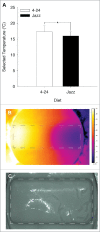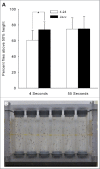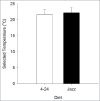Drosophila development, physiology, behavior, and lifespan are influenced by altered dietary composition
- PMID: 28277941
- PMCID: PMC5552271
- DOI: 10.1080/19336934.2017.1304331
Drosophila development, physiology, behavior, and lifespan are influenced by altered dietary composition
Abstract
Diet profoundly influences the behavior of animals across many phyla. Despite this, most laboratories using model organisms, such as Drosophila, use multiple, different, commercial or custom-made media for rearing their animals. In addition to measuring growth, fecundity and longevity, we used several behavioral and physiological assays to determine if and how altering food media influence wild-type (Canton S) Drosophila melanogaster, at larval, pupal, and adult stages. Comparing 2 commonly used commercial food media we observed several key developmental and morphological differences. Third-instar larvae and pupae developmental timing, body weight and size, and even lifespan significantly differed between the 2 diets, and some of these differences persisted into adulthood. Diet was also found to produce significantly different thermal preference, locomotory capacity for geotaxis, feeding rates, and lower muscle response to hormonal stimulation. There were no differences, however, in adult thermal preferences, in the number or viability of eggs laid, or in olfactory learning and memory between the diets. We characterized the composition of the 2 diets and found particularly significant differences in cholesterol and (phospho)lipids between them. Notably, diacylglycerol (DAG) concentrations vary substantially between the 2 diets, and may contribute to key phenotypic differences, including lifespan. Overall, the data confirm that 2 different diets can profoundly influence the behavior, physiology, morphology and development of wild-type Drosophila, with greater behavioral and physiologic differences occurring during the larval stages.
Keywords: D. melanogaster; bioactive peptides; diet; geotaxis; learning; locomotion; memory; morphology; muscle; thermal preference.
Figures







Similar articles
-
Drosophila melanogaster larvae make nutritional choices that minimize developmental time.J Insect Physiol. 2015 Oct;81:69-80. doi: 10.1016/j.jinsphys.2015.07.002. Epub 2015 Jul 4. J Insect Physiol. 2015. PMID: 26149766
-
Comparing the impacts of macronutrients on life-history traits in larval and adult Drosophila melanogaster: the use of nutritional geometry and chemically defined diets.J Exp Biol. 2018 Oct 29;221(Pt 21):jeb181115. doi: 10.1242/jeb.181115. J Exp Biol. 2018. PMID: 30171098
-
Context- and dose-dependent modulatory effects of naringenin on survival and development of Drosophila melanogaster.Biogerontology. 2016 Apr;17(2):383-93. doi: 10.1007/s10522-015-9624-6. Epub 2015 Oct 31. Biogerontology. 2016. PMID: 26520643
-
Using artificial diets to understand the nutritional physiology of Drosophila melanogaster.Curr Opin Insect Sci. 2017 Oct;23:104-111. doi: 10.1016/j.cois.2017.07.014. Epub 2017 Sep 23. Curr Opin Insect Sci. 2017. PMID: 29129274 Review.
-
Does dietary restriction really increase longevity in Drosophila melanogaster?Ageing Res Rev. 2005 Aug;4(3):409-21. doi: 10.1016/j.arr.2004.12.001. Ageing Res Rev. 2005. PMID: 16051527 Review.
Cited by
-
Endogenous coenzyme Q content and exogenous bioavailability in D. melanogaster.Heliyon. 2024 Sep 12;10(18):e37854. doi: 10.1016/j.heliyon.2024.e37854. eCollection 2024 Sep 30. Heliyon. 2024. PMID: 39315151 Free PMC article.
-
Drosophila as a Model for Human Viral Neuroinfections.Cells. 2022 Aug 29;11(17):2685. doi: 10.3390/cells11172685. Cells. 2022. PMID: 36078091 Free PMC article. Review.
-
Pterostilbene Promotes Mean Lifespan in Both Male and Female Drosophila Melanogaster Modulating Different Proteins in the Two Sexes.Oxid Med Cell Longev. 2022 Feb 16;2022:1744408. doi: 10.1155/2022/1744408. eCollection 2022. Oxid Med Cell Longev. 2022. PMID: 35222791 Free PMC article.
-
Aggression Is Induced by Resource Limitation in the Monarch Caterpillar.iScience. 2020 Nov 19;23(12):101791. doi: 10.1016/j.isci.2020.101791. eCollection 2020 Dec 18. iScience. 2020. PMID: 33376972 Free PMC article.
-
Evidence of dietary protein restriction regulating pupation height, development time and lifespan in Drosophila melanogaster.Biol Open. 2019 Jun 6;8(6):bio042952. doi: 10.1242/bio.042952. Biol Open. 2019. PMID: 31171531 Free PMC article.
References
-
- Kopec S. On the influence of intermittent starvation on the longevity of the imaginal stage of Drosophila melanogaster. J Exp Biol 1928; 5:204-11.
-
- Baumberger JP, Glaser RW. The rearing of drosophila ampelophila loew on solid media. Science 1917; 45:21-2; PMID:17832180; https://doi.org/10.1126/science.45.1149.21-b - DOI - PubMed
-
- Doubal S, Klemera P. The effect of antioxidants and dietary restriction on mortality curves. Age (Omaha) 1999; 22:101-5; PMID:23604407; https://doi.org/10.1007/s11357-999-0012-5 - DOI - PMC - PubMed
-
- Anagnostou C, Dorsch M, Rohlfs M. Influence of dietary yeasts on Drosophila melanogaster life-history traits. Entomol Exp Appl 2010; 136:1-11; ; https://doi.org/10.1111/j.1570-7458.2010.00997.x - DOI
-
- Hartman TR, Strochlic TI, Ji Y, Zinshteyn D, O'Reilly AM. Diet controls Drosophila follicle stem cell proliferation via Hedgehog sequestration and release. J Cell Biol 2013; 201:741-57; PMID:23690177; https://doi.org/10.1083/jcb.201212094 - DOI - PMC - PubMed
Publication types
MeSH terms
Grants and funding
LinkOut - more resources
Full Text Sources
Other Literature Sources
Molecular Biology Databases
